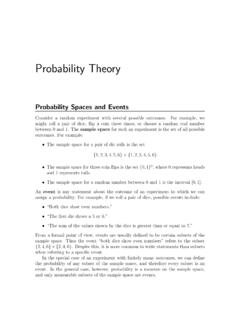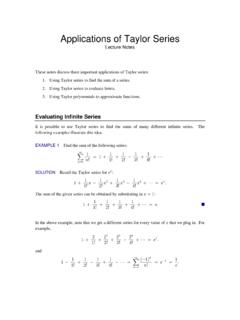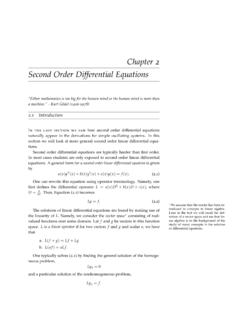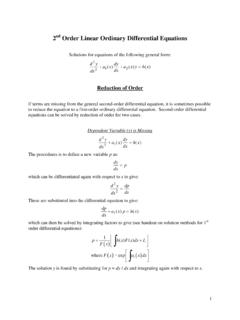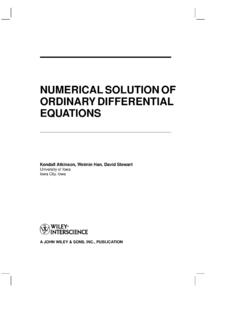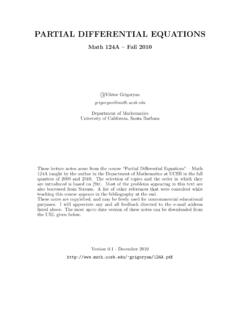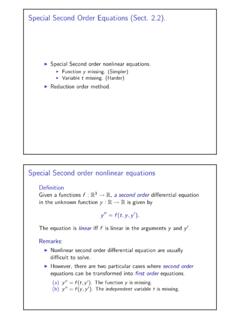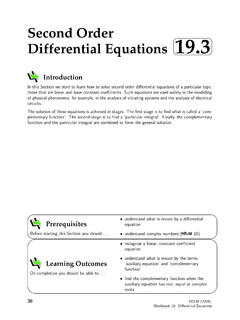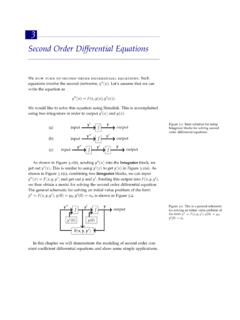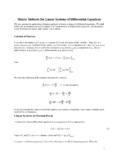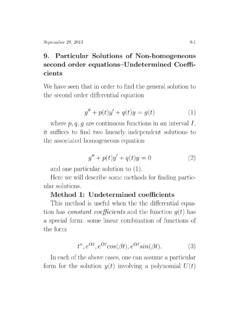Transcription of Applications of Di erential Equations - Bard College
1 3 Applications of differential EquationsDifferential Equations are absolutely fundamental to modern science and all of the known laws of physics and chemistry are actually differential equa-tions, and differential equation models are used extensively in biology to study bio-Amathematical modelis adescription of a real-world systemusing mathematical language reactions, population dynamics, organism growth, and the spread of most common use of differential Equations in science is to modeldynamicalsystems, systems that change in time according to some fixed rule. For such asystem, the independent variable ist(for time) instead ofx, meaning that equationsare written likedydt=t3y2instead ofy = addition, the letteryis usually replaced by a letter that represents the variableunder consideration, mass,Pfor population,Tfor temperature, and Growth and DecayPerhaps the most common differential equation in the sciences is the NATURAL GROWTH EQUATIONT henatural growth equationis the differential equationdydt=kywherekis a constant.
2 Its solutions have the formy=y0ektwherey0=y(0) is the initial value constantkis called therate constantorgrowth constant, and has units ofinverse time (number per second). The sign ofkgoverns the behavior of the solutions: Ifk >0, then the variableyincreases exponentially over time. This is calledexponential growth. Ifk <0, then the variableydecreases over time, approaching zero is calledexponential Figure 1 for sample graphs ofy=ektin these two cases. In the case wherekisk>0tyy=ektk<0tyy=ektFigure 1:Exponential growthand , the natural growth equation can also be writtendydt= rywherer=|k|is positive, in which case the solutions have the formy=y0e following examples illustrate several instances in science where exponentialgrowth or decay is 1 Consider a colony of bacteria in a resource-rich environment. Here resource-rich means, for example, that there is plenty of food, as well as space forAPPLICATIONS OF differential EQUATIONS2the colony to grow.
3 In such an environment, the populationPof the colony will grow,as individual bacteria reproduce via binary that no bacteria die, the rate at which such a population grows will beproportional to the number of bacteria. For example, the population might increase ata rate of 5% per minute, regardless of its size. Intuitively, this is because the rate atwhich individual bacterial cells divide does not depend on the number of can express this rule as a differential equation:dPdt= a constant of proportionality, which can be interpreted as the rate at whichthe bacteria reproduce. For example, ifk= 3/hour, it means that each individualbacteria cell has an average of 3 offspring per hour (not counting grandchildren).It follows that the population of bacteria will grow exponentially with time:P=P0ektwhereP0is the population at timet= 0 (see Figure 2).
4 TPP=P0ektP0 Figure 2: Exponential growth ofa bacteria 2 Consider a sample of a certain radioactive isotope. The atoms of suchan isotope are unstable, with a certain proportion decaying each second. In particular,the massMof the sample will decrease as atoms are lost, with the rate of decreaseproportional to the number of atoms. We can write this as a differential equationdMdt= rM,whereris a constant of proportionality. It follows that the mass of the sample willdecay exponentially with time:M=M0e rt,tMM=M0e-rtM0 Figure 3: Exponential decay of aradioactive the mass of the sample at timet= 0 (see Figure 2). One important measure of the rate of exponential decay is thehalf life. Given adecaying variabley=y0e rt(r >0)the half life is the amount of time that it takes foryto decrease to half of its originalvalue. The half life can be obtained by substitutingy=y0/2y02=y0e rtand then solving , given a growing variabley=y0ekt(k >0)we can measure the rate of exponential growth using thedoubling time, theamount of time that it takes foryto grow to twice its original value.
5 The doublingtime can be obtained by substitutingy= 2y0and then solving following example illustrates a more complicated situation where the naturalgrowth equation 3 Figure 4 shows a simple kind of electric circuit known as anRC circuit has two components: Applications OF differential EQUATIONS3 Aresistoris any circuit component such as a light bulb that resists the flowof electric charge. Resistors obeyOhm s lawV=IR,whereVis the voltage applied to the resistor,Iis the rate at which charge flowsthrough the resistor, andRis a constant called theresistance. Acapacitoris a circuit component that stores a supply of electric charge. WhencapacitorresistorFigure 4: An RC is attached to a resistor, the capacitor will push this charge through the resistor,creating electric current. Capacitors obey the equationV=QC,whereQis the charge stored in the capacitor,Cis a constant called thecapac-itanceof the capacitor, andVis the resulting an RC circuit, the voltage produced by a capacitor is applied directly across aresistor.
6 Setting the two formulas forVequal to each other givesIR= , the rateIat which charge flows through the resistor is the same as the rateat which charge flows out of the capacitor, soI= these together gives the differential equation( dQdt)R=QC,or equivalentlydQdt= follows that the amount of charge held in the capacitor will decay exponentially overtimeQ=Q0e rtwherer= 1/(RC). In the case where the resistor is a light bulb, this means thatAlthough the light bulb willtechnically never go out, in reality thelight will become too faint to see aftera short bulb will become dimmer and dimmer over time, although it will never quite goout. Separation of VariablesMany differential Equations in science are separable, which makes it easy to find 4 Newton s law of coolingis a differential equation that predicts thecooling of a warm body placed in a cold environment.
7 According to the law, the rateat which the temperature of the body decreases is proportional to the difference oftemperature between the body and its environment. In symbolsdTdt= k(T Te), Applications OF differential EQUATIONS4whereTis the temperature of the object,Teis the (constant) temperature of theenvironment, andkis a constant of can solve this differential equation using separation of variables. We get dTT Te= k dt,soln|T Te|= kt+ forTgives an equation of the formT=Te+Ce kttTT=Te+Ce-ktT0 TeFigure 5: Cooling of a the value ofCchanged. This function decreases exponentially, but approachesTeast instead of zero (see Figure 5). EXAMPLE 5In chemistry, the rate at which a given chemical reaction occurs isoften determined by a differential equation. For example, consider the decompositionof nitrogen dioxide:2 NO2 2 NO + this reaction requires two molecules of NO2, the rate at which the reactionoccurs is proportional to thesquareof the concentration of NO2.
8 That is,We are using the usual chemistrynotation, where [NO2] denotes theconcentration of NO2. An alternativewould be to use a single letter for thisconcentration, such [NO2]dt= k[NO2]2where [NO2] is the concentration of NO2, andkis a can solve this equation using separation of variables. We get [NO2] 2d[NO2] = k dtso [NO2] 1= kt+ for [NO2] gives[NO2] =1kt+Ct@NO2D@NO2D=1kt+CFigure 6: Decomposition of the value ofCchanged. An example graph corresponding to this formula isshown in Figure 6. Unlike exponential decay, the concentration decreases very quicklyat first, but then very slowly afterwards. EXAMPLE 6 Consider a colony of bacteria growing in an environment with limitedresources. For example, there may be a scarcity of food, or space constraints on thesize of the colony. In this case, it is not reasonable to expect the colony to growexponentially indeed, the colony will unable to grow larger than some maximum populationPmaxiscalled thecarrying capacityof thebacteria colony in the this case, a common model for the growth of the colony is thelogistic equationdPdt=kP(1 PPmax)Here the factor of 1 P/Pmaxis unimportant whenPis small, but whenPis close toPmaxthis factor decreases the rate of growth.
9 Indeed, in the case whereP=Pmax, thisfactor forcesdP/dtto be zero, meaning that the colony does not grow at OF differential EQUATIONS5We can solve this differential equation using separation of variables, though it is abit difficult. We begin by multiplying through byPmaxPmaxdPdt=kP(Pmax P).We can now separate to get PmaxP(Pmax P)dP= k integral on the left is difficult to evaluate. The secret is to express the fraction asthe sum of two simpler fractions:PmaxP(Pmax P)=1P+1 Pmax is a simple example of theintegration technique known aspartial fractions of the simpler fractions can then be integrated easily. The result isln|P| ln|Pmax P|=kt+ can use a logarithm rule to combine the two terms on the left:ln PPmax P =kt+CsoPPmax P= forPgivesP=Pmax1 +Ce ktwhere the value +Ce-ktPmaxFigure 7:Logistic 7 shows the graph of a typical solution.
10 Note that the population growsquickly at first, but the rate of increase slows as the population reaches the , the population asymptotically approachesPmax. In many of the examples we have seen, a differential equation includes an unknownconstantk. This means that the general solution will involvetwounknown constants(kandC). To solve such an equation, you will need two pieces of information, such asthe values ofy(0) andy (0), or two different values following example illustrates this 7An apple pie with an initial temperature of 170 C is removed fromthe oven and left to cool in a room with an air temperature of 20 C. Given that thetemperature of the pie initially decreases at a rate of C/min, how long will it takefor the pie to cool to a temperature of 30 C?SOLUTIONA ssuming the pie obeys Newton s law of cooling (see Example 4), we havethe following information:dTdt= k(T 20),T(0) = 170,T (0) = ,whereTis the temperature of the pie in celsius,tis the time in minutes, andkis anunknown can easily find the value ofkby plugging the information we know aboutt= 0directly into the differential equation: = k(170 20).

